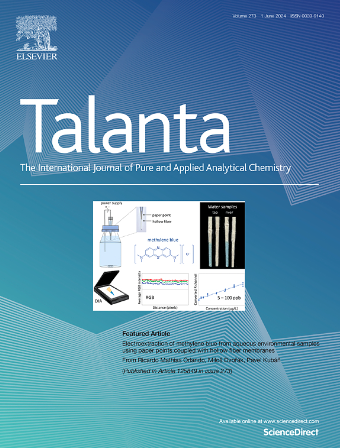基于纳米酶的食品污染物检测生物传感器:进展、挑战和前景
IF 6.1
1区 化学
Q1 CHEMISTRY, ANALYTICAL
引用次数: 0
摘要
食品污染物的存在对公众健康构成越来越大的威胁。开发先进、可靠、高灵敏度、高特异性、高重复性的食品污染物检测方法是食品安全控制的迫切要求。纳米酶以其模拟酶的催化活性和纳米材料独特的物理化学性质而被广泛应用于各种食品安全检测生物传感器的开发中。近年来,相关出版物呈指数级增长,引起了相当大的研究兴趣。本文综述了近五年来在过氧化物酶和氧化酶类纳米酶的催化机制方面的最新进展,并对近五年来基于纳米酶的食品污染物检测生物传感器的构建、传感机制和实际应用进行了全面的讨论。这些生物传感器包括比色、荧光、化学发光、电化学、表面增强拉曼散射、多模态和其他类型,用于检测食品污染物,如真菌毒素、病原体、农药、兽药、非法添加剂和重金属。综述了该领域目前面临的挑战和前景,旨在总结纳米酶传感平台的进展,促进进一步探索以保障食品安全为基础的纳米酶传感平台。本文章由计算机程序翻译,如有差异,请以英文原文为准。

Nanozyme-based biosensors for food contaminants detection: advances, challenges, and prospects
The presence of food contaminants poses a growing threat to public health. Developing advanced and reliable biosensing methods with high sensitivity, specificity, and reproducibility for detecting food contaminants is an urgent requirement for food safety control. Nanozymes, recognized for their enzyme-mimicking catalytic activities and the unique physicochemical properties of nanomaterials, have been extensively utilized in the development of diverse biosensors for food safety assays. Recent years have witnessed an exponential surge in relevant publications, garnering considerable research interest. This review summarizes recent advancements in the catalytic mechanisms of peroxidase- and oxidase-like nanozymes and provides a comprehensive discussion on the construction, sensing mechanisms, and practical applications of nanozymes-based biosensors developed for detecting food contaminants over the past five years. These biosensors include colorimetric, fluorescence, chemiluminescent, electrochemical, surface-enhanced Raman scattering, multi-modal, and other types, used for detecting food contaminants such as mycotoxins, pathogens, pesticides, veterinary drugs, illegal additives, and heavy metals. The review also addresses current challenges and prospects in this field, aiming to summarize advancements and promote further exploration of nanozyme-based sensing platforms to guarantee food safety.
求助全文
通过发布文献求助,成功后即可免费获取论文全文。
去求助
来源期刊

Talanta
化学-分析化学
CiteScore
12.30
自引率
4.90%
发文量
861
审稿时长
29 days
期刊介绍:
Talanta provides a forum for the publication of original research papers, short communications, and critical reviews in all branches of pure and applied analytical chemistry. Papers are evaluated based on established guidelines, including the fundamental nature of the study, scientific novelty, substantial improvement or advantage over existing technology or methods, and demonstrated analytical applicability. Original research papers on fundamental studies, and on novel sensor and instrumentation developments, are encouraged. Novel or improved applications in areas such as clinical and biological chemistry, environmental analysis, geochemistry, materials science and engineering, and analytical platforms for omics development are welcome.
Analytical performance of methods should be determined, including interference and matrix effects, and methods should be validated by comparison with a standard method, or analysis of a certified reference material. Simple spiking recoveries may not be sufficient. The developed method should especially comprise information on selectivity, sensitivity, detection limits, accuracy, and reliability. However, applying official validation or robustness studies to a routine method or technique does not necessarily constitute novelty. Proper statistical treatment of the data should be provided. Relevant literature should be cited, including related publications by the authors, and authors should discuss how their proposed methodology compares with previously reported methods.
 求助内容:
求助内容: 应助结果提醒方式:
应助结果提醒方式:


